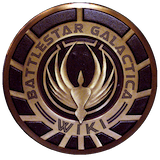→Battlestar Galactica: Origins: The original typo, that caused a chain of typos. |
|||
| Line 488: | Line 488: | ||
In April 2009, Tokyopop released a manga edition entitled ''[[Battlestar Galactica: The Manga -- Echoes of New Caprica]]'', with stories by Emily Salzfass, Richard Hatch and Mike Wellman, and art by Chrissy Delk, Christopher Schons and Anthony Wu. This first volume contained three stories: | In April 2009, Tokyopop released a manga edition entitled ''[[Battlestar Galactica: The Manga -- Echoes of New Caprica]]'', with stories by Emily Salzfass, Richard Hatch and Mike Wellman, and art by Chrissy Delk, Christopher Schons and Anthony Wu. This first volume contained three stories: | ||
# ''[["Teacher's Pet"]]'' (writer: Emily Salzfass, artist: Chrissy Delk) | # ''[[Battlestar Galactica: The Manga -- Echoes of New Caprica#Teacher's Pet|"Teacher's Pet"]]'' (writer: Emily Salzfass, artist: Chrissy Delk) | ||
# ''[["Shelf Life"]]'' (writer: Richard Hatch, artist: Christopher Schons) | # ''[[Battlestar Galactica: The Manga -- Echoes of New Caprica#Shelf Life|"Shelf Life"]]'' (writer: Richard Hatch, artist: Christopher Schons) | ||
# ''[["Visitation"]]'' (writer: Mike Wellman, artist: Anthony Wu) | # ''[[Battlestar Galactica: The Manga -- Echoes of New Caprica#Visitation|"Visitation"]]'' (writer: Mike Wellman, artist: Anthony Wu) | ||
== References == | == References == | ||
Revision as of 14:58, 30 January 2012

|
Care to help document every Battlestar comic? Dig up those comics from your basement or bookstore and join other contributors in the Book and Comic Development Project! |
Battlestar Galactica has been adapted into comic book form since its inception, by a number of different publishers including Marvel Comics, Whitman Comics, Maximum Press, Realm Press, and Dynamite Entertainment. This article provides an overview of the publishing history and links out to individual articles for each series and issue.
- Battlestar Wiki hosts articles on all officially-licensed comics through its separate continuity policy.
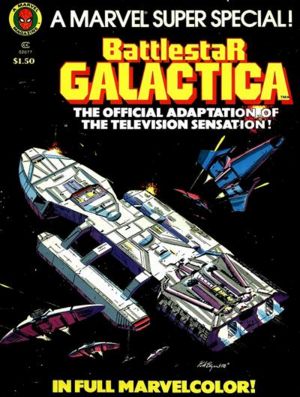
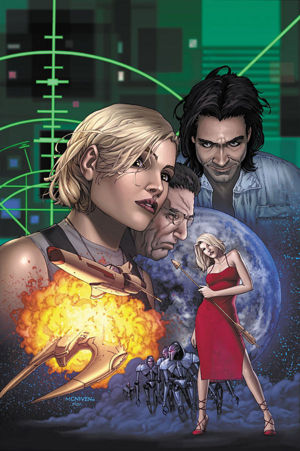
Marvel Comics[edit]
Marvel Comics began its adaptation of Galactica with Super Special 8. Super Special was a magazine format comic book that featured different characters or adaptations each month. Issue 8 was produced just in time for the launch of the TV series in September 1978.
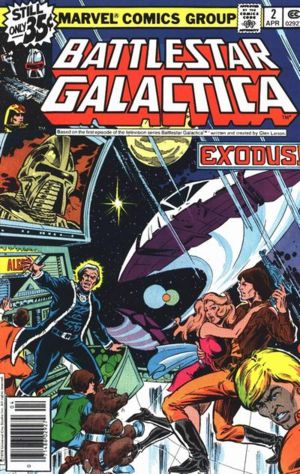
The Super Special adaptation was derived from an interim script of "Saga of a Star World", and some of the differences in the story are evident. This adaptation was also released in a tabloid format by both Marvel Comics and Whitman Comics.
Spurred on by the success of this adaptation, Marvel began a monthly comic series that ran from 1978 through 1980, and lasted a total of 23 issues. The first three issues, titled Battlestar Galactica, Exodus! and Deathtrap! respectively, consisted of a longer adaptation of Saga of a Star World, taking much of the art from the Super Special adaptation and expanding it by several pages.
The adaptation of the series continued in next two issues entitled Into the Void and A Death in the Family, which chronicled the story from the two part television episode "Lost Planet of the Gods".
Beginning with The Memory Machine, Marvel began publishing all new stories based on the characters in the series. From this point, the story began to depart from what was depicted in the series. According to letters pages within the publication, Marvel's contract with Universal Studios specifically did not allow them to use anything from the television series that followed "Lost Planet Of The Gods".
In the storyline that unfolded, a good deal of the comic took place in the magnetic void which the fleet first encountered in the TV episode "Lost Planet of the Gods". In the end of the TV episode, the fleet moves back into normal space, leaving the void behind, but in the comics the rag tag fleet remains in the void beginning in issue #4, with the fleet finally returning to regular space in issue #14. (This makes placing the episodes within the span of the TV series difficult, since much of the action could be surmised to have taken place between "Lost Planet of the Gods" and "Lost Warrior".)
In terms of tone, many of the Marvel comics had horror elements, a theme that was visited sparingly in the TV series. An incomplete list of monsters from the comic series would include a space vampire (issue #9), a carnivorous planet (issue #10), alien vermin (issue #15), a crewmember who transforms into a red ape (issues #17 and #18) and a monstrous shapeshifter (issue #21). Even the menacing and relentless Cylon Mark III in issue #16 owes as much of his origin to horror elements as he does to science fiction. Taken as a whole, Marvel’s Galactica is somewhat darker in tone than the series, but this not-so-subtle paranoia is arguable truer to the initial premise of the series than were some of the latter episodes of the television program.
Notably, the writers of the Galactica comic were quite willing to remove key characters from the dramatic mix for periods of time. From issues #6 to #12, Commander Adama is placed within a machine to help him remember the ancient writings he briefly saw on Kobol and, although we do spend some time in his dreams, he is effectively removed from commanding the Galactica for several issues, which of course sets up its own dramatic tension.
Another character who leaves the series for awhile is Starbuck, as part of perhaps the most effective story arc in the series. In this plotline the fleet stumbles upon Scavenger World, the dominion of the female space pirate Eurayle, who makes a deal to spare the Colonials if she can keep Starbuck at her side. The interactions between Starbuck and Eurayle are memorable, and the conclusion of the storyline, with a tremendous battle in issue #13, is a satisfying conclusion. At the end of the tale, Starbuck remains with Eurayle, and the fleet moves on without him, which of course sets us up for his triumphant return in issues #19 and #20.
Unlike both television series, the Galactica comic actually had a planned ending, with a series of plot devices being wound up in the final two part story of issues #22 and #23. In the course of solving a mystery, Lieutenant Jolly finds adventure and romance and helps in figuring out the long sought coordinates for Earth. A tongue in cheek adventure ably drawn and scripted by Walt Simonson this plotline provided a strong end for a memorable series.
Overall Review of the Marvel Series[edit]
The Marvel Galactica series had great potential because comics were better equipped for science fiction stories than television was back in 1978 (unlike today when relatively inexpensive CGI special effects allow television to do sci-fi/fantasy series such as Bablyon 5, Xena, and Hercules that wouldn't have been possible even 10 years earlier). The range of stories in the Galactica television series were limited because there was not enough time on a weekly TV schedule to shoot special effects scenes. In comics, artists can easily create entire universes and blow them up at will. This advantage should have led to better stories than what we saw on the television episodes, but overall the TV series was still much better what Marvel gave us. The main problem was the writing. It was consistently average, and too often mediocre. Only 5 issues - #11, 12, 13, 16, and 19 - are above-average.
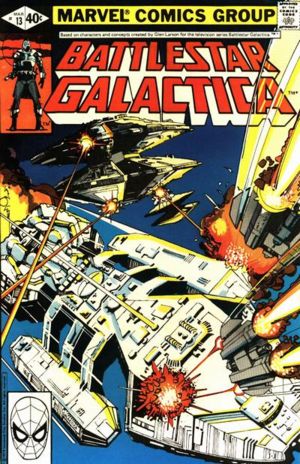
The adaptations of Saga Of A Star World and Lost Planet Of The Gods are okay, but nothing special. 3 issues simply wasn't enough to do justice to the pilot episode, and neither were 2 issues enough for Lost Planet (Note: The only noticeable difference between the comic and the televison series is that Serina dies on the planet Kobol, but this was probably done to shorten the story more than anything else.) Issue #6 has Adama submit himself to a device called The Memory Machine in an attempt to remember the coordinates of the planet Earth that he had briefly seen on the planet Kobol before Cylon fire destroyed the writings. In #7, a revolt causes the machine's controls to be damaged, thus trapping Adama inside the machine (Removing him after that would have destroyed his sanity). Adama is trapped inside the machine until #12, and there is a great deal of monotony inbetween. #8 and #10 are devoted entirely to stories from Adama's past (which Adama is reliving due to the Memory Machine). #8 is a forgettable story of Adama and Tigh as young warriors. #10 is better, as it involves a major battle with Cylons that involves Starbuck and Apollo. #9 - "Space Mimic", however, is hands down the worst issue of the entire series (an alien shape-shifter boards the Galactica and assumes the identity of Adama).
The Marvel series hits a crescendo with #11, 12, and 13. The Colonial fleet discovers a gigantic alien ship (if you could call it that) called Scavenge World. It inhabitants are various kinds of aliens who capture starcraft and dismantle them for their own private use. Starbuck is captured and receives, without trying, the romantic interest of Eurayle, the beautiful human female empress of Scavenge World. He tells her of the pursuing Cylons and gets her to agree to spare the Colonial fleet in exchange for helping Scavenge World lead the Cylons into a trap. Eurayle has mind control powers which she says can free Adama of the Memory Machine, but only if Starbuck agrees to remain behind with her. Starbuck accepts her offer, and she manages to free Adama just as the Cylons attack. The space battle is particularly gripping as Lucifer (now the Cylon leader; he makes a comment that implies Baltar is dead) has a Cylon basestar attempt to ram the Galactica head on. This is an exceptional story that never could have been done on the television series due to its limited special effects.
The series falls apart after this story. The Cylons don't appear again, except for a single advanced Cylon in #16 and an illusional battle with Cylon raiders in #21 (Don't ask). What's frustrating is that Marvel does things that the television series should have done -- the compelling Sire Uri sticks around and is the perfect foil for Adama -- Boomer, Athena, and Jolly are each featured in their own individual stories -- yet it fails to do them in a compelling fashion. Of the remaining stories, only #16 and #19 are particularly memorable. In #16, Apollo comes across an advanced Cylon (The Mark III) in an advanced Cylon raider. This is turns out to be a legitimately gripping story.
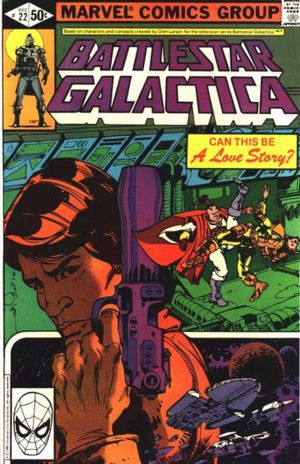
Issue #19 deals with Starbuck's escape from Scavenge World. It is very funny as Starbuck embellishes everything to make it look like he had a friendly parting with Eurayle. As he tells his version, the reader is allowed to see the actual events that occurred: Eurayle learns of Starbuck romancing other women, and she tries to kill him; he barely escapes with his life. #20 has Eurayle and other Scavenge World ships pursuing the fleet, but it never gets interesting. The last two issues, #22 and #23, comprise a two-part story that centers around Jolly trying to uncover civilian piracy within the Colonial fleet. Jolly gets a love interest, but the story doesn't even tread water. In #23 the Galactica finally uncovers the coordinates to Earth. The series ends with the Colonial fleet using new technology to hyperwarp to Earth.
This is a let-down ending. Talk about ending with a whimper instead of a bang. Couldn't there at least have been a final battle with the Cylons? We know the Colonials will reach Earth, but we aren't even allowed to see what Earth is like. Oh well, at least the Marvel series ended with some sort of closure, unlike the TV series.
The only real positive thing that can be said about the last 8 or so issues of the Marvel series is that there is a noticeable improvement in the artwork, particularly the illustrations of the Galactica. Still, it's not enough to save the stories. The cancellation of the TV series certainly had something to do with the decline in the comic's readership, but the biggest factor had to have been the poor writing. The Marvel series had the potential to produce better stories than the TV series did, but sadly it failed.
In closing, the Marvel Comics Battlestar Galactica series is poor overall. Like Galactica 1980, it is best left forgotten. It is recommended only for the most fanatical of Galactica fans.
Marvel Comics Monthly Comic Book[edit]
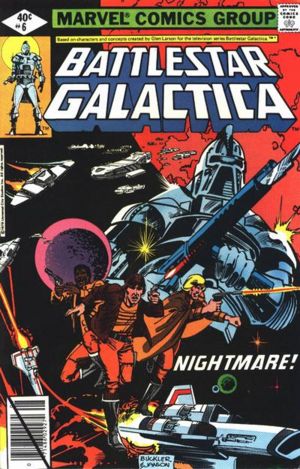
- 1 Battlestar Galactica
- 2 Exodus!
- 3 Deathtrap!
- 4 Into the Void
- 5 A Death in the Family
- 6 The Memory Machine
- 7 All Things Past and Present
- 8 Shuttle Diplomacy!
- 9 Space-Mimic!
- 10 This Planet Hungers
- 11 Scavenge World - Image Gallery included
- 12 The Trap! - Image Gallery included
- 13 Collision Course! - Image Gallery included
- 14 Trial and Error
- 15 Derelict!
- 16 Berzerker - Image Gallery included
- 17 Ape and Essence
- 18 Forbidden Fruit!
- 19 The Daring Escape of the Space Cowboy - Image Gallery included
- 20 Hell Hath No Fury!
- 21 A World for the Killing!
- 22 Black is the Color of My True Love's Hair
- 23 The Last Hiding Place - Image Gallery included
SuperSpecial Adaptation[edit]
Marvel Super Special 8: Battlestar Galactica
While not a great adaptation, what makes this comic interesting is that it is based on an early script of the pilot, and thus there are several distinct differences.
- Differences from the Televised Pilot
-
Baltar is executed by the Cylons.
-
Lyra (Serina) is told that she is dying from radiation sickness.
-
Cassiopeia does not survive the Ovion mines.
-
In the final scene, Lyra says good-bye to Apollo.
Titan Books Marvel reprints - trade paperbacks[edit]
- Saga of a Star World by Roger McKenzie, Ernie Colon and Walt Simonson
- The Memory Machine by Roger McKenzie, Klaus Janson, Walt Simonson and Tom DeFalco
Look-In Magazine[edit]
Look-In Magazine, a UK based publication for children, published a serialized comic strip featuring Galactica from October 20, 1979 through October 11, 1980. The four untitled storylines spanned 52 issues, and contained 13 two page chapters per storyline. A very solid composition throughout, this incarnation of the rag tag fleet has been largely overlooked.[1]
- Storyline 1 (issues 1979 #43 to 1980 #3)
- Storyline 2 (issues 1980 #4 to 1980 #16)
- Storyline 3 (issues 1980 #17 to 1980 #29)
- Storyline 4 (issues 1980 #30 to 1980 #42)
Grandreams Annuals[edit]
The UK company Grandreams came out with two Battlestar Galactica hardcover annuals, which contained short text and comic book stories. Far inferior to the Look-In strips, these comics were aimed primarily at children.
Battlestar Galactica Annual[edit]
COMIC STRIPS:
- Battlestar Galactica [adapts ep. 1-3]
- Chess-Players of Space
- Bane of Baal Farr
- Amazons of Space
SHORT FICTION:
- Doomsday Rock
- Swamp World
- Hijack in Space
Mission Galactica Annual: The Cylon Attack[edit]
COMIC STRIPS:
- Part One: Switch in Space
- Part Two: Planet of the Cyclops
- Part Three: Skirmish Beyond Skafrax
- Part Four: Final Showdown
SHORT FICTION:
- Dice With Death
- Enemy Within
Maximum Press[edit]
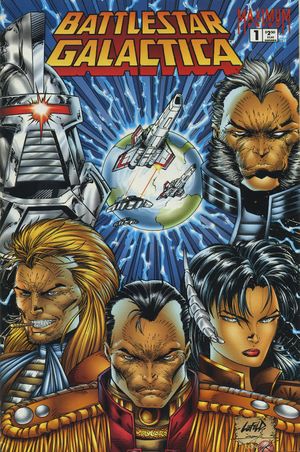
For a very long time, Battlestar Galactica did not appear in comics. Finally, in July of 1995, Maximum Press (a Rob Liefeld imprint) published a miniseries that continued the Galactica mythos, and ignored the storyline from Galactica 1980. It had a distinct advantage in that it was the first new Galactica comic in 14 years (The horrible Marvel series ended in 1981) and thus at the outset seemed like a breath of fresh air. Perhaps to try to prevent burnout, MP published a number of 3 to 4-issue limited series rather than a single ongoing comic.
The artwork was usually good, yet wrong because the writers decided to change all the ship designs, giving us the explanation that the Colonials and Cylons have upgraded their technology over the 20 odd years since the final episode of the series. (Was this done to help promote the new Galactica toyline that was being trotted out at the time?) While it might be plausible for the vipers to have been upgraded, it is very difficult to believe that the Galactica could have been completely revamped given the scarce limit of resources within a rag-tag fleet. Even the Pegasus (which eventually shows up) looks different and has a super cannon. Considering that Cain had a virtual skeleton crew when he disappeared, this is an even harder thing to accept. None of the new ship designs can compare with the classic originals.
Like the Marvel series, MP was not legally able to use the actors' likenesses. Apollo suffers the most because not only is his face different, but he is given a different haircut. Starbuck, Athena, and Cassiopea are adequate, and Baltar actually looks pretty cool. Lucifer and the Cylons look awful, however.
Major spoilers alert from here on out. The first series, War of Eden, is fairly good. Strangely, the Galactica discovers Earth almost immediately (You would think they would put this off until much later down the line). Unfortunately for the Colonials, they find more questions than answers. Earth turns out to be deserted except for a single temple with two humans who turn out to be Adam and Eve. It is revealed that the humans of Earth have left the planet and scattered among the stars. This resolution of the Earth premise is a bit of a disappointment, although understandable because if the Galactica's journey ended here, there would be no story left to tell.
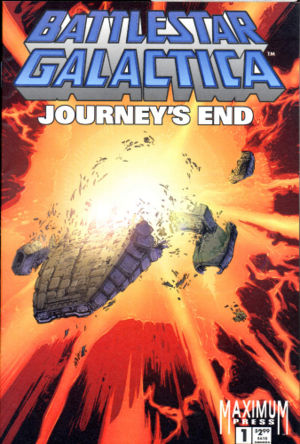
Apollo and Sheba are married now and have a son named Cain. The Colonials have evaded the Cylons for all these years due to a warp system given to them by the Seraphs (an invented name for the beings on the Ship of Lights). But Count Iblis teams up with Baltar to lead the Cylons to Earth, and Baltar winds up killing Adama. Just as the Colonials are about to be destroyed, the Seraphs show up and provide some razzle-dazzle wizardry, causing the Battlestar Pegasus to warp to the battle and save the day.
Unfortunately, this raises all kinds of questions. If the Seraphs can warp ships around at will, why haven't they directly interfered in the Colonials behalf before, especially during the peace armistice? Why didn't they warp the Colonial fleet to Earth years ago? It also hurts the credibility of the Cylons as a threat. It seems like the writers are taking the easy way out rather than trying to answer any of these questions.
There is one part of the story that helps make up for all this. In issue #3, Count Iblis takes Sheba to the old wrecked ship on the red planet from the War Of The Gods episode and has her look inside. (Apollo had prevented her from doing so before). When she looks inside, she sees the dead body of her father, Commander Cain! It all is a trick, of course, to turn her against Apollo, but it is clever for the writers to play off the popular Galactica myth that the crashed ship is the Pegasus and that Apollo prevented Sheba from looking inside because he had found Cain's body.
In issue #4, in what is probably the highlight of the entire series, Apollo recalls what he saw inside the ship: a cloven hoof belonging to a demon (as described in the original script of the episode). And we are given a great visual image of the demon!
The next 3-issue series was The Enemy Within. Baltar has a saboteur (a Cylon disguised as a human) manipulate his way aboard the Galactica to try to destroy the warship from the inside. Ironically, Maximum Press was the one of the first to give us a human Cylon, beating Ron Moore to the punch by 8 years! The Cylon, named Ares, has a love affair with Athena and actually sleeps with her. The story works adequately, but with an interesting twist. Starbuck and the Cylon are jettisoned in a pod which is believed destroyed. Later, it would be revealed that the pod crashed on a desert planet and Starbuck survived. By having Starbuck marooned on a desert planet with a dead Cylon, the writers appear to be playing off the classic Galactica 1980 episode The Return of Starbuck in which the same thing happens.
There is another 3-issue series called Starbuck which, after a promising start, quickly disappoints. The story takes place during the events of the original TV series (There should have been more stories in this timeframe). The Galactica is attacked by a fleet of Eastern Alliance destroyers. This is a great idea and something the original series probably would have done if it had had the time and money needed to shoot such an elaborate battle. Unfortunately, the comic cuts away in the middle of the battle (just as the Galactica takes a direct hit from a destroyer, no less!) as Starbuck's viper is damaged. Then once again we are subjected to the yawner plot of "Starbuck crashes on a planet." Didn't we see enough of this on the TV series? Sadly, we never see the rest of the battle. The rest of the Starbuck series is pretty much forgettable.
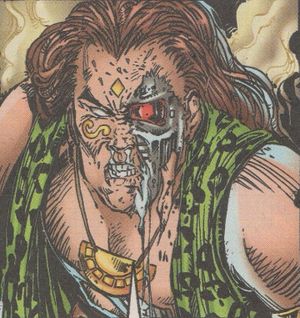
The next 3-issue series is Apollo's Journey. Written by Richard Hatch himself, it is the best of all the MP series. Hatch shows the other writers how it's done as Apollo once again faces Count Iblis. Definitely worth picking up.
The last of the MP series that I've read is the four-issue Journey's End. I'm going to go into great detail about it because I have stronger feelings about this series than any other that MP has done. Here is a great example of what happens so often in sci-fi/fantasy stories: a legitimately gripping, intense story is completely undercut by an unnecessary injection of fantasy elements (in this case, time travel). The first issue is easily the best comic from Maximum Press to date. All kinds of powerful dynamics are at work: The looming imminent Cylon threat; Apollo's battle with Cain and the Council; and then the overwhelming Cylon attack force destroys the Pegasus and the entire fleet except for the Galactica.
The writers are taking a lot of risks here, which makes for exciting story-telling, but not always successful story-telling. That's the downside to creating something as originally fresh as the opening: the challenge of maintaining it for the entire duration of the story.
Unfortunately, all the exciting themes are completely undercut by issue #2. The Galactica is once again saved by the Seraphs. To have the Seraphs simply warp the Galactica away feels like cheating (Again, why didn't they warp the Colonial warfleet away during the peace talks?). Even worse, the Seraphs use time-travel to take the Colonials years into the future where they discover the Eastern Alliance is the ultimate power in the universe and has conquered the Cylons! The resolution of this futuristic plot isn't believable at all. The Colonials are somehow able to reprogram all of the captive Cylons in the entire Eastern Alliance to make them revolt. And when Apollo asks the Seraphs why their lives were put in jeopardy, their response is they were simply trying to teach him a lesson! They would put the Colonials' lives in danger just to teach them a lesson? Some allies!
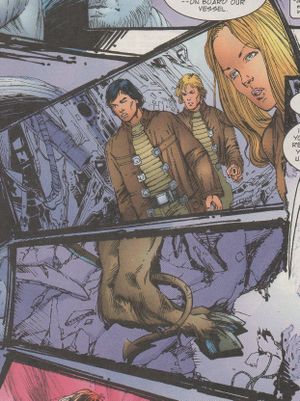
Issue #3 has the Seraphs warp the Galactica into the past just before the destruction of the Colonies, so Apollo is given an opportunity to stop the Holocaust from happening. A potentially great plot is handled horrendously. Rather than simply ambushing the Cylon fleet as it heads towards the fleet, Apollo and Cain go to the Atlantia and actually try to convince President Adar and the Council of Twelve that they are from the future! (Yeah, right.)
Of course, they fail, and the result is that the Colonial warfleet is destroyed by the Cylons as it was before. However, because the Apollo and Zac of that time period pick up the futuristic Galactica on their scanners, they go to investigate and avoid being ambushed by Cylons - thus preventing Zac's death.
Now try and grasp this finish:
The Colonials are able to use a futuristic Cylon they captured to order all the attacking Cylon fighters to return to base, thus granting the Colonies a temporary reprieve from destruction. This allows more people to escape from the Colonies and thus the Colonial fleet turns out to be much larger than it was before.
The Colonials from the future give Adama the coordinates to Earth before warping back to their own time, but they arrive just before discovering Earth. So the fleet still survives because now the disastrous battle from issue #1 never happened. The Pegasus also survives, but it is back where it was when the events of the MP comics first started. Starbuck is somehow still stranded on the remote planet (even though the events that put him there will never happen). Zac is alive on the Galactica from the past, yet he's nowhere to be found on the present Galactica. Apollo's mother, Ila, also survives, and she decided to come aboard the present Galactica instead of the past Galactica for some odd reason. Apollo decides to send the fleet to settle Earth, but the Galactica will head out among the stars to try to find what happened to the Thirteenth Tribe. He believes that Iblis will leave the Colonials on Earth alone and focus on the Galactica.
Confused? So am I, and I'm the one explaining it!!!
Unfortunately, this happens all the time in fiction, television, and movies - a potentially great story self-destructs halfway through (although in this case it happens one-fourth way through). What is particularly insulting is that all the events of the earlier MP comics are erased; they never happened. To spend so much time and effort on a bunch of "never-mind" stories is a waste (and a slap in the face to fans that spent their hard-earned dollars on those comics). When you think about it, since Adama now has the coordinates to Earth from the beginning of the Galactica's journey, he certainly took the fleet on a different heading, thus all the events of the television series are erased as well! Does this also mean that Apollo and Sheba never meet, and thus never marry?
If this all sounds screwed up, it is. None of the plot twists and resolutions are believable. Trying to make sense of the implications is like trying to grab jello, although it's almost typical for time-travel stories (which rarely make much sense anyway). This kind of story manipulation is what largely killed off the Spider-man comics (it was revealed that Spider-man had been a clone for the past 25 years and that the real Spider-man had been off somewhere with amnesia!) It's probably a moot point, but the artwork in #3 and #4 is atrocious.
As it turns out, there wasn't much more to come. After the publishing of a compendium volume in early 1997, Maximum announced it would cease publishing comics based on Battlestar Galactica.
Despite their many flaws, the comics actually seemed good compared to what Marvel gave us. But overall the Maximum Press Galactica comics get a major thumbs down, just like the Marvel comics.
Maximum Press Image Gallery[edit]
War of Eden[edit]
- War of Eden #1
- War of Eden #2
- War of Eden #3 - Image Gallery included
- War of Eden #4 - Image Gallery included
The Enemy Within[edit]
Starbuck[edit]
- Starbuck #1
- Starbuck #2 - Image Gallery included
- Starbuck #3
Apollo's Journey[edit]
Journey's End[edit]
Asylum (monthly anthology series)[edit]
- Issue #1: Baptism of Fire, Part #1
- Issue #2: Baptism of Fire, Part #2
- Issue #3: Baptism of Fire, Part #3
- Issue #4: Athena’s Quest, Part #1
- Issue #5: Athena’s Quest, Part #2
- (No BSG story in issue #6)
- Issue #7: Athena’s Quest, Part #3
- Issue #8: First Date
- (No BSG story in issue #9)
- Issue #10: The Rebirth of Cy, Part #1
- (No BSG story in issue #11)
NOTE: "Athena's Quest" was originally titled "Apollo's Quest"
Battlestar Galactica: The Compendium[edit]
Battlestar Galactica: Special Edition[edit]
Realm Press[edit]
In 1998, Realm Press brought Battlestar Galactica back to comics again beginning with their Battlestar Galactica Search for Sanctuary single issue special. Other one shots were subsequently published. Later, Realm introduced a monthly comic titled Battlestar Galactica Season 3. This series only ran for three issues before it was canceled, and shortly thereafter Realm abandoned the project altogether.
The Realm series was notable for its use of airbrushed art and its attempts to remain faithful to the look and feel of the Original Series.
Battlestar Galactica, Season II[edit]
- Issue 1: The Law of Volahd, Part 1 (2 alternate covers)
- Issue 2: The Law of Volahd, Part 2
- Issue 3: Prison of Souls, Part 1 (2 alternate covers)
- Issue 4: Prison of Souls, Part 2
- Issue 5: Prison of Souls, Part 3
Battlestar Galactica, Season III[edit]
- Issue 1: No Place Like Home (3 alternate covers)
- Issue 2: Hades Hath No Fury (4 alternate covers)
- Issue 3: Fire in the Sky (3 alternate covers)
The New Millennium[edit]
- Fear of Flying / Favorite Son / Tales of the Pegasus: Chapter One, Daddy’s Girl (3 alternate covers)
Eve of Destruction[edit]
Search For Sanctuary[edit]
1999 Tourbook[edit]
- Dark Genesis (3 alternate covers) - Image Gallery included
Battlestar Galactica Special Edition[edit]
- Centurion Prime (2 alternate covers)
Gallery Special[edit]
- The Care and Feeding of Your Daggit / Masquerade - Image Gallery included
Cancelled one-shots and Season III comics[edit]
- Colonial Technical Journal, Volume 1 - Image Gallery included
- Dire Prophecy (2 alternate covers)
- Darkest Night (2 alternate covers)
- Battlestar Black and White (2 alternate covers)
- Cylon Dawn (2 alternate covers)
- No-Man’s Land (2 alternate covers)
- Minor Difficulties (anthology of short tales)
- Battlestar Galactica Season III issue 5
- Battlestar Galactica Season III issue 8
Dynamite Entertainment[edit]
In May 2006, Dynamite began releasing a comic series based on the Re-imagined Series. The comics are set within the framework of the show and, at at first were set between the episodes "Home, Part II" and "Pegasus".
Beginning in late September 2006 Dynamite began releasing an Original Series continuation series.
In October 2006, a miniseries focusing on the Re-imagined Series character Tom Zarek was released, focusing on Zarek's past.
In September 2009, a miniseries focusing on a "re-imagined" Galactica 1980 was released. A sequel, Galactica 1981, was scheduled to be released in 2010, but the series never materialized.
Re-imagined Series[edit]
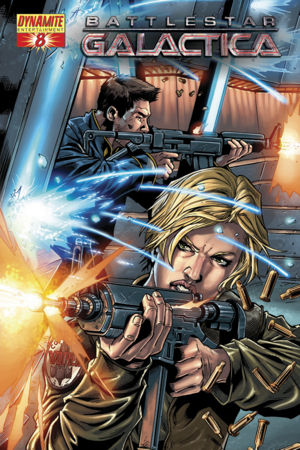
The first series of issues based on the Re-imagined Series written by Greg Pak and pencilled by Nigel Raynor. The storyline appears after the events of "Home, Part II" and before "Pegasus" and significantly diverge from the Re-imagined Series' timeline of Season 2.
- Battlestar Galactica 0
- Battlestar Galactica 1
- Battlestar Galactica 2
- Battlestar Galactica 3
- Battlestar Galactica 4
- Battlestar Galactica 5
- Battlestar Galactica 6
- Battlestar Galactica 7
- Battlestar Galactica 8
- Battlestar Galactica 9
- Battlestar Galactica 10
- Battlestar Galactica 11
- Battlestar Galactica 12
All thirteen issues have been collected in the following trade paperbacks:
- Battlestar Galactica Volume I (Issues #0 - #4)
- Battlestar Galactica Volume II (Issues #5 - #8)
- Battlestar Galactica Volume III (Issues #9 - #12)
Battlestar Galactica: Zarek[edit]
This miniseries explores the history of Tom Zarek.
- Battlestar Galactica: Zarek 1
- Battlestar Galactica: Zarek 2
- Battlestar Galactica: Zarek 3
- Battlestar Galactica: Zarek 4
Battlestar Galactica: Season Zero[edit]
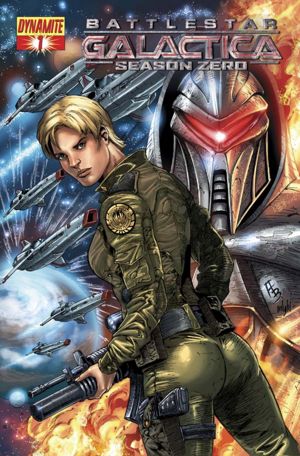
Written by Brandon Jerwa and penciled mainly by Jackson Herbert, this series chronicles the first mission of Galactica under the command of Commander William Adama, dealing with terrorism in the Twelve Colonies.
- Battlestar Galactica: Season Zero 0
- Battlestar Galactica: Season Zero 1
- Battlestar Galactica: Season Zero 2
- Battlestar Galactica: Season Zero 3
- Battlestar Galactica: Season Zero 4
- Battlestar Galactica: Season Zero 5
- Battlestar Galactica: Season Zero 6
- Battlestar Galactica: Season Zero 7
- Battlestar Galactica: Season Zero 8
- Battlestar Galactica: Season Zero 9
- Battlestar Galactica: Season Zero 10
- Battlestar Galactica: Season Zero 11
- Battlestar Galactica: Season Zero 12
Battlestar Galactica: Pegasus[edit]
Brandon Jerwa wrote an one-shot comic based on Admiral Helena Cain and Pegasus, the events to which occur prior to the Fall of the Twelve Colonies.
Battlestar Galactica: Origins[edit]
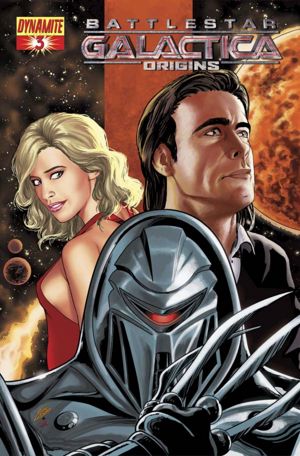
Origins is a comic book series that explores the beginnings of various important Re-imagined Series characters, including Gaius Baltar, William Adama, Kara "Starbuck" Thrace and Karl "Helo" Agathon. Issues #1 through #4 deal with the life of Gaius Baltar, while issues #5 through #8 reveal the history William Adama and issues #9 through 11 focus on Kara Thrace and Karl Agathon.
- Battlestar Galactica: Origins 1
- Battlestar Galactica: Origins 2
- Battlestar Galactica: Origins 3
- Battlestar Galactica: Origins 4
- Battlestar Galactica: Origins 5
- Battlestar Galactica: Origins 6
- Battlestar Galactica: Origins 7
- Battlestar Galactica: Origins 8
- Battlestar Galactica: Origins 9
- Battlestar Galactica: Origins 10
- Battlestar Galactica: Origins 11
All the issues in this series have been collected in trade paperbacks:
- Battlestar Galactica Origins: Adama (#1-4)
- Battlestar Galactica Origins: Baltar (#5-8)
- Battlestar Galactica Origins: Starbuck and Helo (#9-11)
Battlestar Galactica: Ghosts[edit]
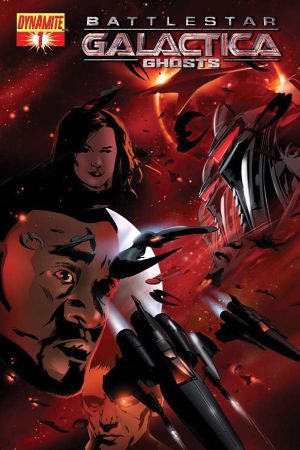
Written by Brandon Jerwa, this four issue mini-series consists of new characters outside of the Battlestar Galactica "mainstream" who are part of the Ghost Squadron, a black-ops team struggling to survive after the wake of the Fall of the Twelve Colonies.
- Battlestar Galactica: Ghosts 1
- Battlestar Galactica: Ghosts 2
- Battlestar Galactica: Ghosts 3
- Battlestar Galactica: Ghosts 4
Battlestar Galactica: Cylon War[edit]
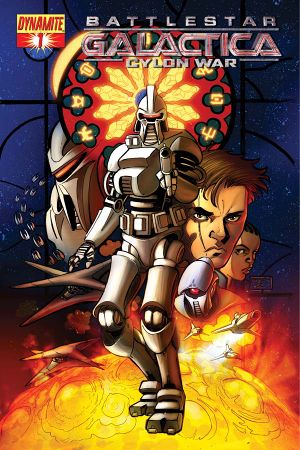
Written by Joshua Ortega and Eric Nylund, this four issue mini-series tells the tale of the Cylon War decades before the Fall of the Twelve Colonies.
- Battlestar Galactica: Cylon War 1
- Battlestar Galactica: Cylon War 2
- Battlestar Galactica: Cylon War 3
- Battlestar Galactica: Cylon War 4
Battlestar Galactica: The Final Five[edit]
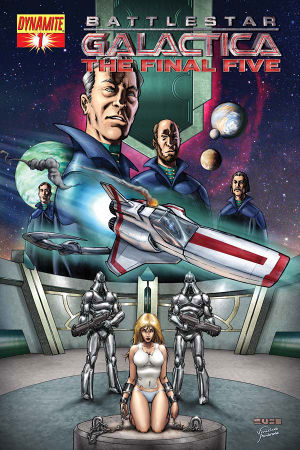
Written by Seamus Kevin Fahey, David Reed and Nigel Raynor, this four issue event ties directly into the events of the final episodes of the Re-imagined Series.
- Battlestar Galactica: The Final Five 1
- Battlestar Galactica: The Final Five 2
- Battlestar Galactica: The Final Five 3
- Battlestar Galactica: The Final Five 4
Classic Battlestar Galactica[edit]
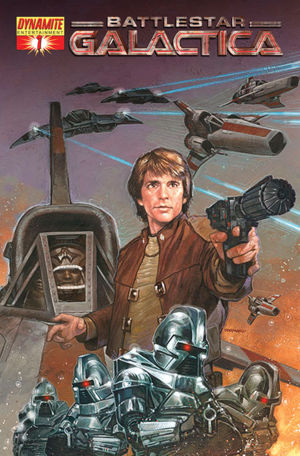
Dynamite produced a short-lived comic book run based on the Original Series. Beyond both this and the Cylon Apocalypse series, Dynamite has been focusing on comics based on the Re-imagined Series.
- Classic Battlestar Galactica 1
- Classic Battlestar Galactica 2
- Classic Battlestar Galactica 3
- Classic Battlestar Galactica 4
- Classic Battlestar Galactica 5
Battlestar Galactica: Cylon Apocalypse[edit]
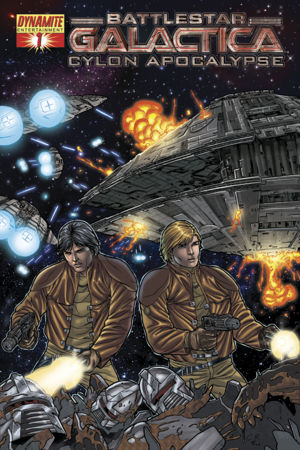
A four-part mini-series written by Javier Grillo-Marxuach that details the story of the Colonials' discovery of a virus that can destroy their Cylon foes and how they try to weaponize it.
- Battlestar Galactica: Cylon Apocalypse 1
- Battlestar Galactica: Cylon Apocalypse 2
- Battlestar Galactica: Cylon Apocalypse 3
- Battlestar Galactica: Cylon Apocalypse 4
All four installments of the series have been collected in the Battlestar Galactica: Cylon Apocalypse trade paperback.
Galactica 1980[edit]
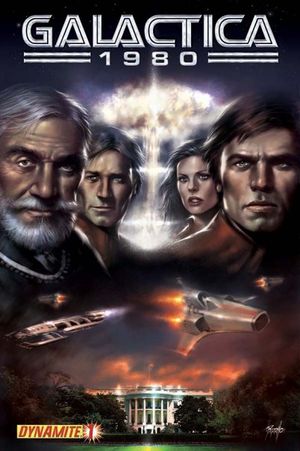
A "re-imagined" Galactica 1980 written by Marc Guggenheim was released September 2009.
Galactica 1981[edit]
A sequel to the Galactica 1980 comics, taking place a year after the end of that series, was scheduled to be released in late 2010, but never came about.
Tokyopop[edit]
In April 2009, Tokyopop released a manga edition entitled Battlestar Galactica: The Manga -- Echoes of New Caprica, with stories by Emily Salzfass, Richard Hatch and Mike Wellman, and art by Chrissy Delk, Christopher Schons and Anthony Wu. This first volume contained three stories:
- "Teacher's Pet" (writer: Emily Salzfass, artist: Chrissy Delk)
- "Shelf Life" (writer: Richard Hatch, artist: Christopher Schons)
- "Visitation" (writer: Mike Wellman, artist: Anthony Wu)
References[edit]
- ↑ John's Look-out: A Guide to Look-in the Junior TV Times (backup available on Archive.org) (in ). Retrieved on 30 December 2007.
